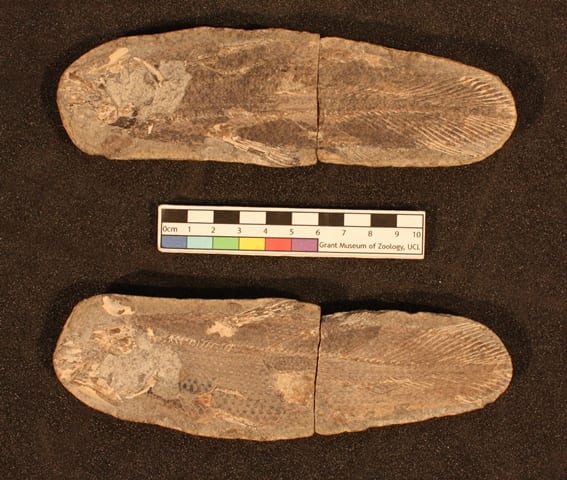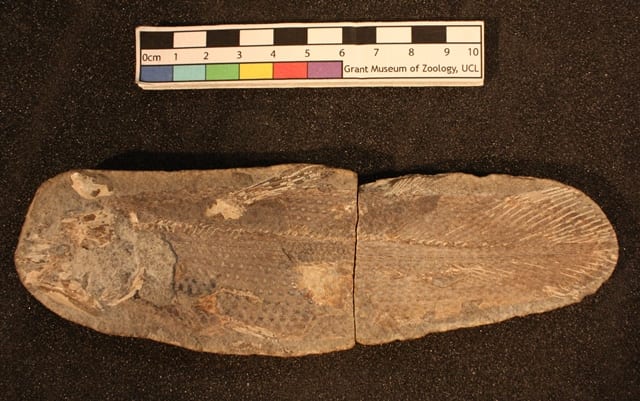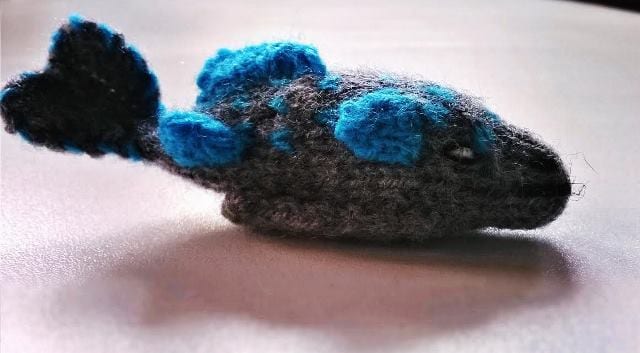Underwhelming Fossil Fish of the Month: March 2015
By Mark Carnall, on 31 March 2015
After last month’s deeply underwhelming fossil fish of the month the head of the network has been in touch to ask if I can sex it up a bit for everyone’s favourite month, March. So normally in this bit I go on about how this blog series is all about completely underwhelming fossil fish, here’s where you can read all the old ones etc. etc. However, today I’ll inform you to strap yourself into whatever undergarments you find yourself wearing because this month I’m going for it. This is the first ever actinisitian underwhelming fossil fish of the month (take that, fictional network heads). I know right? Hype-tastic. What’s even more exciting is that this month’s underwhelming fossil fish is a non-coelacanthiform, coelacanthid, Coelacanthus which is a coelacanth but not the coelacanth (pronounced see-la-canth). But no! I’ve said too much. I should have kept some of the excitement for below. Let’s have a look at the star specimen in question:
Thar she blows, a lovely specimen in four pieces. According to the label, this is a Triassic example of a fish in the genus Coelacanthus collected from Greenland. As I mentioned above this is the first actinisitian fish we’ve featured here. Actinistia is a group of lobe-finned fish that include amongst many fossil species the two species of living coelacanths. Coelacanths are often referred to as living fossils as these animals were only known from the fossil record from the 1830s until the remarkable discovery of living coelacanths off the coast of South Africa in 1938. A second living species was described from Indonesia in 1999.
Although in a very literal way they can be considered living fossils, the term living fossil is problematic as it’s often merely a quirk in the historical discovery of living animals that results in a species ending up described as a living fossil (all living animals could be called living fossils). The term suggests that living fossils are something of a blast from the past when in actual fact they’ve just been secretely rocking their thing for a long time very successfully thank you very much. Living coelacanths are also often described as Lazarus taxa, that is, taxa that have come back from the dead but again this refers to an observational artefact than an instance of species specific resurrection.
As I alluded to earlier, what we call our lovely fossil here is a real head-scratcher. In popular culture we call the two living species of coelacanths, both in the genus Latimeria, coelacanths even though the name coelacanth comes from the earlier discovered extinct Coelacanthus, which our fossil here is. Doubly confusingly, the entire taxonomic tree for some coelacanths uses the same stem word so our fish here is a coelacanthiform, coelacanthid, Coelacanthus. However, modern cladistics has thrown a spanner in the works as some studies place Coelacanthus outside of the clade Coelacanthiforms, the group that contains modern non-Coelacanthus coelacanths. Further confusing the matter this fossil is labelled ‘Coelacanth sp.’ which isn’t a valid genus name so I’m not too sure if this means this is a species of Coelacanthus or generically a species of coelacanth but one that hasn’t been specified or speciated. Either way it’s a coelacanth. Coelacanth. Coelacanth.
Coelacanths are lobe-finned fish in the group Sarcopterygii, the group that modern tetrapods (amphibians, birds, reptiles, mammals) evolved from. The lobe-fins have articulations that later evolved to become the limbs and limb girdles we know and love today.
Preservation This fossil is in four pieces and rather beautifully preserved inside a calcareous nodule as with one of our previous underwhelming fossil fish which was also collected from Greenland. Unfortunately, the head appears to have undergone some decomposition, bits of the jaws can be seen but more detail is possibly preserved beneath and could be prepared out of the specimen. The preservation of the rest of the specimen is very nice. The arrangements of the outer scales has been preserved as well as the spine. The caudal, anal and pectoral fins have been preserved as has the first dorsal fin and part of the second dorsal fin. Some of the bones supporting the lobe fins can be seen but not in amazing detail unfortunately.
Research A quick trawl through the literature and there isn’t a huge amount of gripping research on Coelacanthus beyond many papers reporting new fossil species here and there. This is a specimen from the collection of former Grant Museum curator and fish palaeontologist extraordinaire, D.M.S Watson so I was expecting this specimen to be figured, however, it doesn’t seem to have been published. What I did discover though is an account which claims D.M.S Watson was one of the people present at a special meeting of the Linnaean Society convened to examine photographs of the discovery of modern coelacanths which I didn’t know beforehand. Apparently the convention of experts gave the surprising discovery their blessing.
In Society I’m cheating only a little bit here as it’s not really about Coelacanthus but coelacanths (enough now?) but one of my favourite ways in which coelacanths have had an influence in popular culture is through the immensely popular video game series Pokémon. Amongst the 700 odd virtual critters is one species called Relicanth (round of applause for whoever was responsible for that portmanteau). According to one of the in-game descriptions Relicanth is: “A Pokémon that was once believed to have been extinct. The species has not changed its form for 100 million years. It walks on the seafloor using its pectoral fins”. Which is a nice homage even if the date is a little bit off. My other favourite depiction in popular culture is this coelacanth finger puppet I bought from the Pitt Rivers Museum and this is not at all the only reason why I fished out (boom boom) this particular fossil for this month’s Underwhelming Fossil Fish of the Month…
Coelacanthus? sp.
Preservation 8
Research 1.5
In Society 4
Underwhelmingness 6
Mark Carnall is the Curator of the Grant Museum of Zoology
One Response to “Underwhelming Fossil Fish of the Month: March 2015”
- 1
 Close
Close





Love it, but not nearly underwhelming enough! A real amateur fossil hunter, like my dad, would be proud to put on display haha